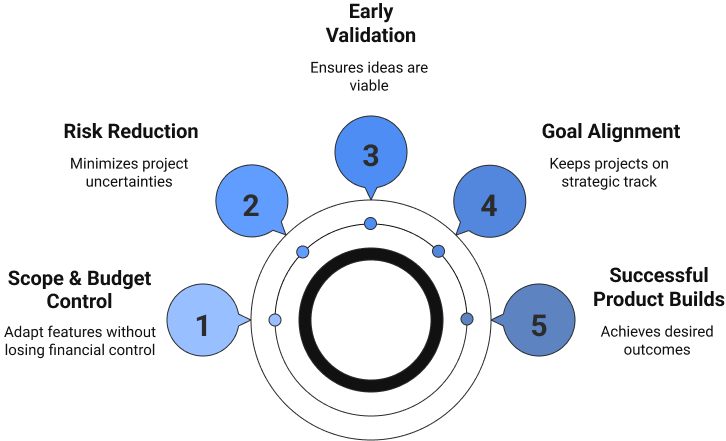
Agile is often seen as a shortcut to faster development, but its real value lies in how it enables smarter decisions, early risk management, and ongoing alignment with business goals. It’s not just about speed – it’s about building the right thing, step by step.
At its core, Agile is a mindset that emphasizes flexibility, collaboration, and continuous feedback. By breaking work into smaller, testable units, teams can quickly adapt, pivot when needed, and ensure each iteration delivers real value.
In this post, we’ll explore the key benefits of Agile software development methodology – beyond the surface – and share practical insights from how we apply it at Developex to build better, more aligned software.
What Is Agile Software Development Is – And How It Works
Agile isn’t just a trendy software development methodology – it’s a shift in how teams approach product development. In the context of software development Agile vs Waterfall, this approach emphasizes flexibility, collaboration, and continuous delivery, while Waterfall relies on rigid, sequential phases. It’s about embracing change rather than resisting it and delivering value incrementally rather than betting everything on a single, long-term plan.
According to the 17th Annual State of Agile Report, 71% of organizations report using Agile approaches for most or all of their software development projects. This number has steadily grown over the years, reflecting a widespread recognition of Agile’s benefits in managing complexity, improving product quality, and accelerating time-to-market.
The core of Agile lies in its focus on collaboration, adaptability, and continuous improvement. In practice, Agile breaks down large projects into smaller chunks, called sprints, that last 1–4 weeks. At the end of each sprint, teams deliver something tangible, often a piece of working software, allowing for quick feedback and early adjustments.
Methodology foundation comes from the Manifesto for Agile software development, which focuses on:
- Individuals and interactions over processes and tools
- Working software over comprehensive documentation
- Customer collaboration over contract negotiation
- Responding to change over following a plan
In essence, Agile is about iterative development and constant feedback, giving teams the flexibility to adapt to changes and the ability to quickly prioritize what matters most for the project.
Different Agile Software Development Methodologies – One Mindset, Many Roads
Agile isn’t limited to one specific method – it’s a flexible philosophy that can be implemented in multiple ways. Here are a few of the most commonly used approaches:
| Methodology | Core Idea | Best For |
| Scrum | Fixed-length sprints, team roles, and ceremonies like stand-ups and retrospectives | Cross-functional teams building complex products |
| Kanban | Continuous flow, visual task boards, and work-in-progress limits | Support teams or projects with fast-changing priorities |
| Lean | Eliminate waste, deliver fast, and focus on value | Resource-limited environments or fast MVP cycles |
| XP | Emphasis on engineering excellence, frequent releases, and testing | Teams with high technical complexity and quality requirements |
There’s no one-size-fits-all – the strength of Agile lies in its adaptability.
How Agile’s Advantages Help You Stay Competitive
Agile software development isn’t just about moving fast – it’s about moving smart. While many teams adopt Agile to accelerate delivery, the real value of the methodology lies deeper: in its ability to reduce risk, validate ideas early, and keep business goals front and center throughout the development process.
Agile gives product teams the structure and flexibility to build the right thing – not just ship features quickly. With iterative planning, frequent feedback loops, and adaptive prioritization, Agile aligns development efforts with real-world needs and changing market demands. Below, we explore the key business and technical benefits that Agile software development methodology brings to modern software projects – including insights from our experience applying it across hundreds of successful product builds at Developex.

Benefit #1: Early Business Validation, Not Just Early Features
One of the most powerful yet often overlooked advantages of Agile software development is early business validation. Many teams focus on Agile’s ability to deliver features quickly, but speed alone means little if what’s delivered doesn’t solve the right problem.
Agile encourages early and frequent delivery of working product increments, which gives stakeholders and users the chance to provide real feedback within the first few sprints – not months down the line. This feedback loop helps confirm (or challenge) assumptions early, before significant time and budget are spent going in the wrong direction.
From a project management perspective, this is critical. Often, clients come with a predefined list of features. But as the product starts to take shape and users interact with it, priorities shift. Agile app development gives space for that shift. It allows teams to refine the product based on real usage data and stakeholder input – not just on paper requirements.
A well-run Agile process treats this early learning as a success, not a failure. It’s not about how much you build, but how much validated value you deliver. This helps align product goals with actual business needs and reduces the risk of building something polished but irrelevant.
Pro Insight: Use early sprints to test assumptions, not just deliver features. Even a simple prototype can surface unexpected user behavior that changes your entire roadmap for the better.
Benefit #2: Built-In Risk Mitigation Through Transparency
One of Agile’s strongest advantages is its ability to mitigate risks early through constant transparency. In traditional development models, risks and issues often remain hidden until late in the project, when they’re harder and more expensive to fix. With Agile project management , teams are continuously reviewing progress, identifying risks, and adapting to changes in real-time.
Frequent sprint reviews, stand-ups, and retrospectives allow stakeholders to stay informed on progress and potential obstacles. This visibility means that problems are spotted early, whether it’s a misalignment of goals, changing requirements, or technical challenges – allowing the team to pivot or re-prioritize before it’s too late.
This early detection and adaptation process creates a more resilient project that can navigate uncertainties and avoid larger, costly delays.
Pro Insight: Regular retrospectives aren’t just for reflecting on what went wrong – they’re opportunities to uncover hidden risks and make proactive adjustments before they escalate.
Benefit #3: Budget Predictability Through Scope Control
Agile’s iterative approach doesn’t just speed up development – it also provides better budget predictability. In traditional models, the entire project is scoped upfront, often leading to significant budget overruns when unforeseen changes or delays occur. With Agile, you gain control over both scope and budget by working in small, manageable increments.
Each sprint’s focus is well-defined, and the team delivers only what’s prioritized, so clients can adjust the scope as needed without derailing the entire project. This allows for tighter alignment between what’s delivered and what’s being spent, ensuring that resources are used efficiently.
Rather than committing to a fixed scope upfront, Agile project management allows businesses to prioritize the most critical features, delivering them in phases that fit within the available budget.
Pro Insight: Use Agile’s flexibility to prioritize features that will generate the most value early, then scale back or adjust less critical ones as the project progresses, keeping the budget in check.
Benefit #4: Enhanced Collaboration Between Teams and Stakeholders
Agile methodology in software development fosters a culture of collaboration at every stage of the project, breaking down silos between development teams, product owners, and stakeholders. Regular communication through daily stand-ups, sprint reviews, and retrospectives ensures that everyone is on the same page and working towards common goals.
By involving stakeholders early and often, Agile keeps expectations aligned and enables teams to adjust to new insights or changes in priorities. This continuous feedback loop enhances the relationship between the team and client, leading to better outcomes and stronger trust throughout the development process.
Agile’s collaborative approach not only improves project efficiency but also empowers teams to deliver solutions that meet real user needs, rather than working in isolation.
Pro Insight: Make sure to involve non-technical stakeholders regularly. Their perspective can highlight potential issues or opportunities that developers might overlook, keeping the project focused on business value.
Benefit #5: Flexibility to Adapt to Changing Market Demands
In today’s fast-paced business environment, the ability to adapt quickly is crucial. Agile app development allows teams to pivot and adjust as market conditions, user feedback, or business priorities evolve. This flexibility is built into the framework, with each sprint providing an opportunity to reassess the project’s direction and make adjustments.
Unlike traditional methods, which can lock teams into a set plan, Agile embraces change – even late in the process. Whether it’s adding a new feature, shifting priorities, or responding to new competition, Agile software development ensures that the team can continue to deliver value without being constrained by outdated plans.
This adaptability helps businesses stay competitive and ensures that products remain relevant in an ever-changing market.
Pro Insight: Use Agile to your advantage by regularly revisiting your product backlog. Prioritizing features based on the latest market trends and user needs will ensure your product stays aligned with current demands.
Benefit #5: Team Autonomy Drives Better Engineering Outcomes
Agile empowers development teams with a high level of autonomy, allowing them to make key decisions on how to approach tasks, solve problems, and deliver features. This autonomy is crucial for fostering ownership and accountability within the team, leading to more motivated developers and higher-quality outcomes.
When teams have the freedom to choose the best tools, processes, and solutions to meet the project’s goals, they are often more efficient and innovative. This trust in their expertise also boosts morale and encourages continuous learning, which translates into better engineering practices and more robust solutions.
With Agile, teams can experiment, fail fast, and iterate, continuously improving the product and the development process. This ability to self-organize ensures that the most effective solutions are implemented, not just the ones dictated by external decision-makers.
Pro Insight: Give your teams the autonomy to make decisions, but set clear expectations around goals and quality. This balance of freedom and accountability leads to both innovation and responsibility.
Bonus: When Agile For Software Development Doesn’t Work – and Why
While Agile development for app has many benefits, it’s not a one-size-fits-all solution. There are situations where Agile may not be the right fit, and understanding these limitations can help prevent frustration and inefficiencies. Here are some common reasons why Agile might not work:
- Lack of stakeholder engagement: If stakeholders aren’t consistently involved or fail to provide timely feedback, the iterative process can break down, leading to misaligned expectations.
- Unclear goals or requirements: Agile thrives on clear, evolving goals. If project goals are ambiguous or constantly changing without proper justification, it can lead to confusion and lack of direction.
- Inexperienced teams: Agile requires a high level of discipline, communication, and understanding. Teams that are new to Agile may struggle with its principles, leading to poor execution.
- Resistance to change: If team members or stakeholders resist change or prefer traditional ways of working, Agile’s flexibility and iterative nature can face significant pushback.
- Inconsistent commitment from leadership: Agile requires leadership to empower teams, provide resources, and embrace flexibility. Without full organizational commitment, Agile can fail to deliver its intended benefits.
- Short-term focus on deliverables: Agile is about long-term value, but some teams or businesses may focus too much on short-term deliverables, compromising quality or missing strategic goals.

Pro Insight: Agile requires a mindset shift across the organization, not just the development team. Be prepared for an ongoing commitment to change at all levels, from leadership to product teams.
Agile at Developex: Our Practical Approach
At Developex, we don’t just follow Agile software development – we tailor it to the realities of each client’s product and team. Our approach is flexible, pragmatic, and results-driven. Depending on the project type, development stage, and level of requirement clarity, we use Scrum, Kanban, or a hybrid approach to match the context.
Here are the key principles behind how we apply Agile software development in practice:
- Transparency at every stage. Regular demos, planning meetings, and open communication ensure everyone – clients and developers alike – has a clear view of progress and priorities.
- Flexible prioritization. We help clients focus on the features that bring the most business value and quickly adjust the plan when conditions change.
- Micro-iterations for fast validation. Short sprints allow clients to see working results every 1–2 weeks, test them, and guide the direction of development in real-time.
- Autonomous and accountable teams. Our cross-functional teams have domain experience and are empowered to make technical decisions, take responsibility, and deliver high-quality outcomes.
For us, Agile it’s a proven methodology for collaboration that gives clients more control, predictability, and faster time-to-value. This is how we help launch successful products in dynamic, fast-moving environments.
Final Thoughts,
Agile software development is more than just a buzzword – it’s a dynamic, flexible approach that enables teams to deliver real value quickly, adjust to changes seamlessly, and ensure projects are always aligned with business goals. It’s about breaking down complex problems into manageable pieces and continuously improving based on feedback.
But remember: no methodology is a silver bullet. Agile, like any other framework, is a set of tools – its success depends on how well you understand it and how wisely you apply it. The key is knowing when and how to use those tools to fit your specific context and goals.
At Developex, Agile is the cornerstone of how we work, ensuring we remain adaptable and responsive to our clients’ needs. We focus not only on speed but on delivering the right results, with a strong emphasis on collaboration, transparency, and flexibility. By combining Agile with our expertise in custom software development solutions, we help businesses navigate complexities, reduce risks, and maintain control over their projects—ultimately driving better outcomes.
Ready to take your projects to the next level?
Contact us today to learn how Developex’s Agile expertise can accelerate your product development and deliver real value faster. Whether you’re starting from scratch or optimizing an existing process, we’re here to help you succeed.






